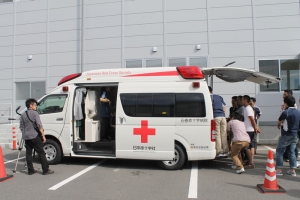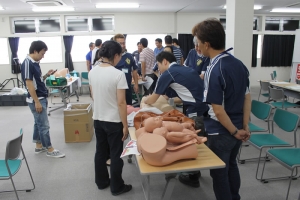Obstetrics and Disaster Preparedness (Part 2 of 3)
Part 2- Obstetrics Support and Training in Tohoku
Nicole Gunawansa | April 8th, 2015
This interview was held on February 18th, 2015 in Tohoku Medical Megabank Building
Question 5: Please explain why and how you modified the BLSO® and ALSO® (Basic and Advance Life Support in Obstetrics) courses to be more specific to Ishinomaki City?

Dr. Sugawara instructed paticipants about pre-hospital deliveries, including in-vehicle deliveries.
Before I describe the modifications, I will provide some back ground about BLSO® and ALSO®. We needed to increase BLSO® training, in Miyagi Prefecture and especially Ishinomaki, because we had a lot of pre-hospital deliveries after the disaster. In 2010, we only had eight pre-hospital deliveries in Miyagi; however, in 2011 we had twenty three pre-hospital deliveries due to an inability to reach the hospital. We wanted to have more hands on training for healthcare provider, nurses, emergency personal, and general practitioners so that they know how to appropriately handle a delivery in a pre-hospital or emergency situation.
ALSO® training is geared towards obstetricians and midwives in hospitals, especially in the coastal area. We are focused on this area because there was an influx of medical teams/volunteers (with various medical backgrounds) that came to the coast to help, but did not understand the best medical treatment for obstetric care. We hope that ALSO® training will help to standardize pre- and postnatal care to ensure better treatment of expecting mothers and their infants. ALSO® is also very important in increasing the skill basis for the remaining obstetricians and midwives in the coastal areas. The migration of such medical professionals (particularly younger generations) from the coast to bigger cities has resulted in a lack of obstetric staff. This is an issue we are trying to combat by increasing preparedness of continuing coastal physicians.
The primary modifications that we have made to BLSO® and ALSO® include 1) setting the situation to be more representative of a disaster and 2) encouraging the exchange of disaster experiences. We want to ensure that our medical staff (and anyone else participating in training) is prepared for what may come with a disaster. So we have modified our courses to include a lack of medical resources to promote creative problem solving. Our goal with information exchange is to build a basis for disaster related care by evaluating how prior medical situations were handled during 3/11. An additional benefit of this exchange is the stimulated therapeutic communication spurred by the sharing of sensitive disaster experiences.
Question 6: How many other areas in Japan offer ALSO® and BLSO® courses? How is your team helping to promote these programs across Japan?

Participation in training courses prepares medical and non-medical professional in emergency obstetrics.
There are actually many ALSO® and BLSO® courses across Japan; yet in the Tohoku region, there is a lack of these training programs. Fukushima just started their BLSO® program in January 2015, and we hope that increased awareness of the importance of obstetrics training will encourage other areas around Miyagi Prefecture to take action.
The biggest difference between the Miyagi ALSO® and BLSO® courses and others across Japan is that we focus on the disaster aspect. Disaster related training is something that I hope will become more of a focus in the future across Japan, but for right now my team is concentrated on increased preparation of the areas affected by 3/11. Our biggest obstacle is the lack of directors and instructors for the training courses, but we are determined to get more qualified directors involved by providing incentives such as certification recognition and networking/information exchanging opportunities.
Another method of promoting these programs is via escalated collaboration with DMAT to certify better prenatal care in disaster situations. Interaction and inter-education systems between ALSO®/BLSO® and DMAT have been expected to start.
Question 6: Could you explain the current midwifery situation in Japan?
Midwifery does not play a big role in Japan as of right now, compared with other countries, especially those in Europe. However, I do think that this area should be promoted for the benefit of the patients. Currently, midwife education programs are just starting to pick up in Japan, and that is a relief to hear. I think that midwives could provide great support in a future disaster situation. It would be fantastic to have a few midwives stationed at every evacuation center to handle obstetric affairs so that an inability to reach a hospital does not have to be a barrier to proper prenatal and delivery care.
